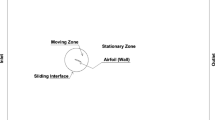Abstract
The aerodynamic effects of leading-edge accretion can raise important safety concerns since the formulation of ice causes severe degradation in aerodynamic performance as compared with the clean airfoil. The objective of this study is to develop a numerical simulation strategy for predicting the particle trajectory around an MS-0317 airfoil in the test section of the NASA Glenn Icing Research Tunnel and to investigate the impingement characteristics of droplets on the airfoil surface. In particular, predictions of the mean velocity and turbulence diffusion using turbulent flow solver and Continuous Random Walk method were desired throughout this flow domain in order to investigate droplet dispersion. The collection efficiency distributions over the airfoil surface in simulations with different numbers of droplets, various integration time-steps and particle sizes were compared with experimental data. The large droplet impingement data indicated the trends in impingement characteristics with respect to particle size; the maximum collection efficiency located at the upper surface near the leading edge, and the maximum value and total collection efficiency were increased as the particle size was increased. The extent of the area impinged on by particles also increased with the increment of the particle size, which is similar as compared with experimental data.
Similar content being viewed by others
References
Bragg, M. B. and Khoudadoust, A., 1995, “Study of the Droplet Spray Characteristics of a Subsonic Wind Tunnel,”AIAA Journal of Aircraft, Vol. 32, pp. 199–204.
Bocksell, T. and Loth, E., 1998, “Stochastic Diffusion Models for Particles in Wakes and Jets,” ASME Summer Fluids Engineering Meeting, FEDSM98–5017, Washington, D.C..
DeAngelis, B. C. Loth, E., Lankford, D. and Bartlett, C. S., 1997, “Computations of Turbulent Droplet Dispersion for Wind Tunnel Test,”AIAA Journal of Aircraft, Vol. 34, No. 2, pp. 2130–2190.
Hancir, P. and Loth, E., 1999, “Computations of Droplet Distribution in the IRT,” AIAA 990097, 37th AIAA Aerospace Sciences Meeting, Reno, NV, January.
Kim, S. D. and Song, D. J., 2005, “Modified Shear-Stress Transport Turbulence Model for Supersonic Flows,” to appear inAIAA Journal of A ircraft.
Kuo, K. K., 1986, Principles of Combustion, John Wiley & Sons, New York.
Maclnnes, J. M. and Bracco, F. V., 1992, “Stochastic Particle Turbulent Dispersion Modeling and the Tracer-Particle Limit,” Physics of Fluids, Vol. 4, No. 2, pp. 2809–2824.
Menter, F. R., 1994, “Two-Equation Eddy-Viscosity Turbulence Models for Engineering Applications,”AIAA Journal, Vol. 32, No. 6, pp. 1598–1605.
Papadakis, M., Rachman, A., Wong, S., Bidwell, C. and Bencic, T., 2003, “An Experimental Investigation of SLD Impingement on Airfoils and Simulated Ice Shapes,” NASA/TM 2003–01–2129.
Snyder, W. H. and Lumley, J. L., 1971, “Some Measurements of Particle Velocity Autocorrelation Functions in a Turbulent Flow,”Journal of Fluid Mechanics, Vol. 48, pp. 41–71.
Yuu, S., Yasukouchi, N., Hirosawa, Y. and Jotaki, T., 1978, “Particle Turbulent Diffusion in a Dust Laden Round Jet,”AIChE Journal, Vol. 24, No. 3, pp. 509–519.
Author information
Authors and Affiliations
Corresponding author
Rights and permissions
About this article
Cite this article
Kim, S.D., Song, D.J. Computations of droplet impingement on airfoils in two-phase flow. J Mech Sci Technol 19, 2312–2320 (2005). https://doi.org/10.1007/BF02916472
Received:
Revised:
Issue Date:
DOI: https://doi.org/10.1007/BF02916472




